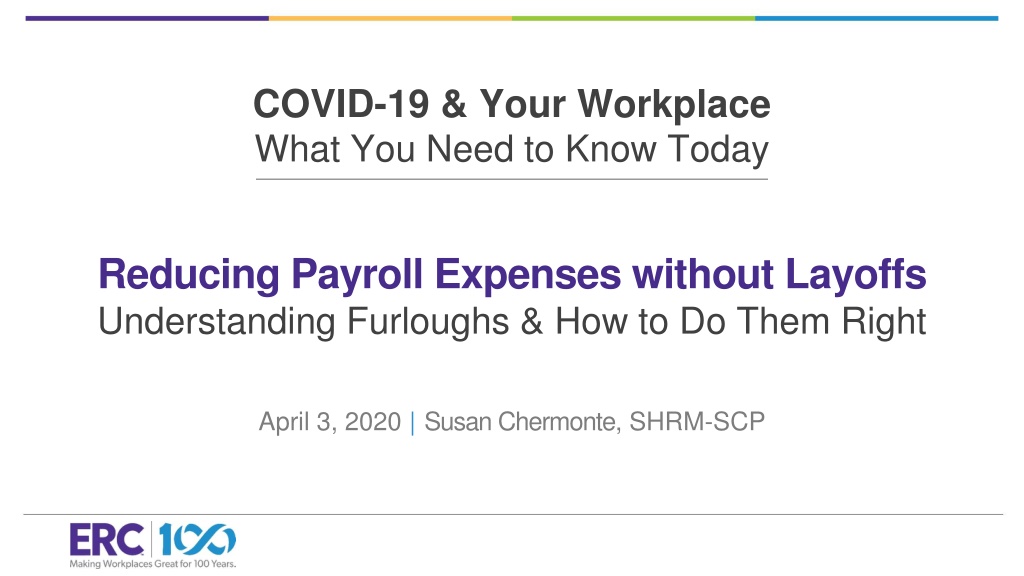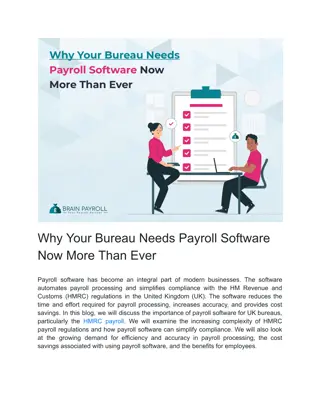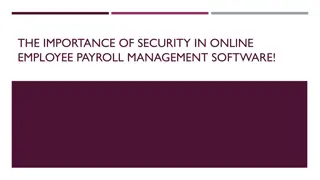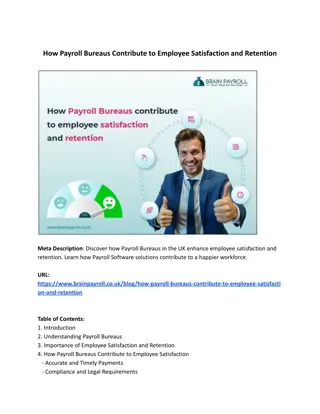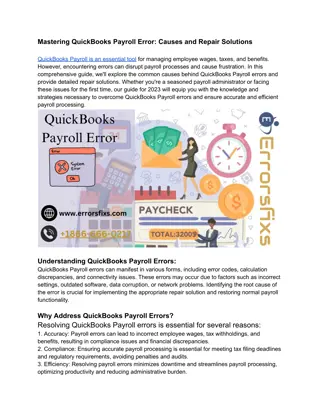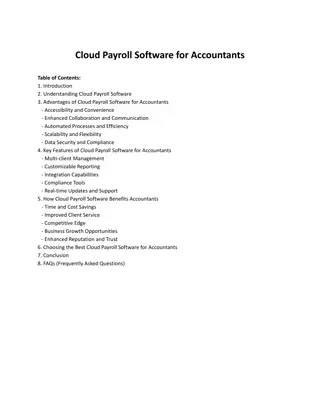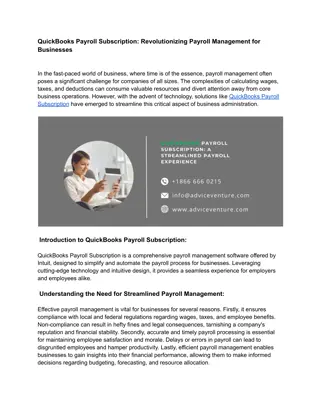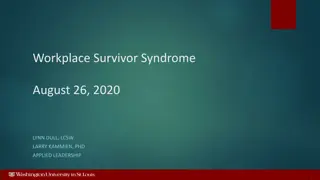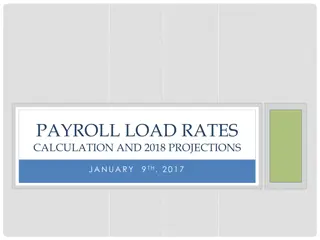Navigating Payroll Expenses: Furloughs vs. Layoffs in Your Workplace
Understand the options for reducing HR costs without layoffs, such as work-sharing, reduced pay, benefits adjustments, and furloughs. Learn the differences between layoffs and furloughs, their impact on employees, and compliance with regulations. Differentiate between exempt and nonexempt employees in terms of payment obligations during reduced work hours.
Download Presentation

Please find below an Image/Link to download the presentation.
The content on the website is provided AS IS for your information and personal use only. It may not be sold, licensed, or shared on other websites without obtaining consent from the author. Download presentation by click this link. If you encounter any issues during the download, it is possible that the publisher has removed the file from their server.
E N D
Presentation Transcript
COVID-19 & Your Workplace What You Need to Know Today Reducing Payroll Expenses without Layoffs Understanding Furloughs & How to Do Them Right April 3, 2020 | Susan Chermonte, SHRM-SCP
AGENDA Options for human resource cost reductions Defining furloughs and layoffs Benefits and unemployment changes during the crisis Ohio Department of Insurance Bulletin Ohio SharedWork Program Federal CARES Act Compliance with the FLSA (Fair Labor Standards Act) How to plan for a furlough or layoff
HR COST REDUCTION OPTIONS Work sharing an Unemployment Insurance program allowing an employer to reduce the number of hours an employee works during a week while unemployment comp makes up some of the difference in income Reduced pay Best if shared by all employees, including management Reduced benefits i.e., eliminating or reducing co. 401(k) contributions Early retirement Attractive incentives for EEs nearing retirement age Voluntarily vacations reduce the liability from the company's books Voluntarily furlough Employee decision must be completely voluntary Involuntary furlough Employee must take unpaid time off: either a few days, a full week or more
LAYOFF VS. FURLOUGH A LAYOFF is a termination of employment at the will of the employer, generally with no expectation of recall to full-time employment. Loss of salary Loss of benefits Eligible for unemployment A FURLOUGH is a short-term reduction of employee hours with an expectation of a return to full-time employment. Salary is reduced, but employee remains on payroll Benefits are maintained May be eligible for unemployment under different programs
NONEXEMPT EMPLOYEES Paid on an hourly vs. salary basis (referred to as hourly employees) Eligible to receive overtime pay for working overtime hours Nonexempt employees need only be paid for actual hours worked If employer is unable to provide work to a nonexempt employee during hours that employee would have usually worked, employer is not required to pay the employee
EXEMPT EMPLOYEES Paid on a salaried basis and not eligible to receive overtime pay Position falls under one of the exemption classifications With few narrow exceptions, when an exempt employee works any part of a week, the employee should be paid for a full week No pay required when employee doesn t work at all during a workweek No deductions may be made from the employee's compensation for time lost caused by the employer or by the operating requirements of the business
DOL DEFINITION OF SALARY A salary is a predetermined amount constituting all or part of the employee's compensation, which is not subject to reduction because of variations in the quality or quantity of the work performed.
FURLOUGHS & EXEMPT EMPLOYEES DOL provides guidance on furloughs in DOL Fact Sheet #70 If employer sets up weeklong furlough or shutdown and doesn t pay exempt employees, there s no risk of losing employees exempt status This is because wage and hour regulations provide that exempt employees need not be paid for any workweek in which they perform no work Salary deductions are generally not permissible if the employee works less than a full day Deductions can only be made for full-day increments
FURLOUGHS & EXEMPT EMPLOYEES If the employer seeks volunteers to take time off due to insufficient work, and the exempt employee volunteers to take the day(s) off for personal reasons other than sickness or disability salary deductions may be made for one or more full days of missed work FLSA requires payment of at least $684 per week on a "salary" basis for employees classified as exempt
FURLOUGHS & EXEMPT EMPLOYEES Employers can substitute an exempt employee's accrued leave (PTO or sick time) or run a negative leave balance for the time an employee is absent from work, even if it is less than a full day and even if the absence is directed by the employer because of lack of work This will not affect the salary basis payment, provided that the employee still receives payment equal to the employee's predetermined salary in any week in which any work is performed, even if the employee has no leave remaining
EMPLOYEE BENEFITS & UNEMPLOYMENT OHIO EMPLOYEE BENEFITS Bulletin 2020-03 Health Insurance Coverage Flexibility for Ohio Employees Mandates relaxed insurance requirements during the present state of emergency and provide additional, more flexible insurance options for employees displaced due to the COVID-19 outbreak.
HEALTH INSURANCE COVERAGE FLEXIBILITY Ohio Employees | New Requirements During the State of Emergency 1) Employee Eligibility Insurers must allow employers to continue employee coverage under group policies, even when an employee would otherwise be ineligible due to a decrease in weekly hours worked. Bulletin temporarily suspends any actively at work or similar policy requirements related to eligibility. 2) Premiums Insurers are prohibited from increasing premiums based on a group s decreased participation or enrollment due to the impact of COVID-19. Also requires insurers to give their employees the option to defer premium payments, interest-free, for up to 60 calendar days from each original premium due date.
HEALTH INSURANCE COVERAGE FLEXIBILITY Ohio Employees | New Requirements During the State of Emergency 3) COBRA For employers with 20 or more employees, eligible EEs may continue coverage under COBRA, as long as one person remains actively employed. Normal notice and election procedures remain applicable. For employers with fewer than 20 employees, eligible EEs may continue coverage under state continuation coverage for up to 12 mos., as long as one person remains actively employed and enrolled. 4) Special Enrollment Period Employees who lose coverage because of COVID-19 may enroll in new insurance coverage. Some individuals may qualify to purchase plans on the federal exchange, which are effective the first day of the next month following enrollment.
EMPLOYEE UNEMPLOYMENT ASSISTANCE Ohio Unemployment All waiting periods are waived for unemployment Under the federal CARES Act: Individuals are entitled to an additional 13 weeks of unemployment on top of the 26 weeks (39 weeks total) Individuals receive an additional $600 on top of regular unemployment
OHIO UNEMPLOYMENT INSURANCE Ohio SharedWork Program Managed by Ohio Department of Jobs and Family Services (ODJFS), the voluntary layoff-aversion program allows workers to receive partial unemployment benefits if a company is forced to reduce employee hours. Program was established in 2015 Workers remain employed, and employers retain trained staff during reduced business activity Waives the work search requirements Participating employer reduces affected employees hours in a uniform manner Participating employees work the reduced hours each week, and the ODJFS provides eligible individuals with an unemployment benefit proportionate to their reduced hours ODJFS will provide proportionate compensation for up to 50% of hours not paid by an employer
connectwERC Share your feedback on the Ohio SharedWork Program on connectwERC Included with your membership, connectwERC provides a private platform for ERC members to ask questions, share answers, and virtually network with other HR professionals If you are not yet registered for connectwERC, please email membership@yourERC.com for access.
CARES ACT Federal Coronavirus Aid Relief & Economic Security Act Advance payment of payroll credit Option for employers to defer payroll tax payments for 2020 Direct payments to individuals Expanded unemployment benefits Paycheck protection provides small businesses, certain nonprofits and other entities with zero-fee loans up to $10 million. Up to 8 weeks of average payroll and other costs will be forgiven if the business retains employees and their salary levels Employer payments of student loans excluded from income Penalty on early distributions from retirement accounts waived
ADMINISTERING FURLOUGHS Exempt Employees Best approach give employees a choice Hold a staff meeting and advise employees of financial concerns Request volunteers who can afford to work reduced workweek Document with an email or simple statement that they understand the circumstances and volunteer to take unpaidtime off Documentation is important if ever audited by DOL Deductions in whole-day increments, not hourly or by whole workweek Pay must not drop below the $684/week minimum salary requirement This will allow employer to maintain exemption status for the employee
ADMINISTERING FURLOUGHS Exempt Employees If employer mandates the furlough because of business operating requirements, furlough should be made for an indefinite period of time Weeklong furloughs are recommended, but if done by day, need to be full-day increments only Employers that furlough an exempt employee must be very clear that the employee cannot do any work. That means: NO checking voice mail and email NO making work-related phone calls Employers may consider removing the employee from all work access (computer and phone) during weeks or days of furlough
WAGE REDUCTIONS Nonexempt Employees Non-exempt employees must meet the Ohio minimum wage requirement of $8.70. (Federal is $7.25).
REDUCTION IN FORCE (RIF) When determining who should be included in layoff, employers usually consider: Skills Work record (performance reviews) Seniority In order to avoid problems, the rationale for a layoff needs to be: Based on business necessity Clear Convincing Analyze data for disparate or adverse impact, EEO, and other legal implications
REDUCTION IN FORCE (RIF) Review federal and state Worker Adjustment and Retraining Notification (WARN) Act regulations to stay compliant Review Older Workers Benefit Protection Act (OWBPA) regulations for compliance Other considerations according to company financial ability include severance agreement packages: Adequate severance pay Outplacement Health benefits Other benefits
EXIT PROCESS Termination meeting Determine who will be there and who will say what Treat laid off employees with respect and dignity Acknowledge anger and disappointment Explain the exit process and provide termination letters (if used) Severance benefits pay and medical insurance Review severance/separation agreement Require signed agreement and set expiration date Recommend employees obtain legal review Age Discrimination in Employment Act (ADEA) laws Reconsideration period for employees over 40 years of age Final paychecks
EXIT PROCESS Notice of COBRA Rights Provide COBRA letter with cost information 401(k) Information Provide contact information Life Insurance Continuation Provide forms or contact information Unemployment Entitled to benefits Employee needs to initiate claim Company will not contest References Letters of recommendation should go through HR Authorization to release references or employment information Notify remaining workforce of the layoffs before the end of the day
ASSIST REMAINING EMPLOYEES Reduced security, increased workload, altered work assignments, changes in organizational priorities, and the loss of coworkers (and possible friends) Remain visible and available to employees following layoffs Give employees an accurate picture of what is happening in the organization after the layoffs Honestly communicate and answer questions to keep morale and productivity high going forward Hold frequent meetings for problem-solving and decision-making Recognize and thank employees for their effort and cooperation Retention is a #1 priority
EMPLOYER RESOURCES ERC Coronavirus Resource Center https://www.yourerc.com/myerc/coronavirus/ Department of Labor Q&A document on DOL website addresses furloughs: https://www.dol.gov/agencies/whd/fact-sheets/70-flsa-furloughs Ohio Department of Insurance Coronavirus-related changes to employee group health coverage: ODI Bulletin 2020-03 [pdf] Federal CARES Act The bill provides various tax relief and loan provisions to assist businesses impacted by COVID-19. It also provides additional unemployment benefits for individuals affected by the pandemic.
EMPLOYER RESOURCES DOL webinar available for employers beginning Friday, 4/3/2020 visit: https://www.dol.gov/agencies/whd/pandemic Families First Coronavirus Response Act: Employee Paid Leave Rights https://www.dol.gov/agencies/whd/pandemic/ffcra-employee-paid-leave Families First Coronavirus Response Act: Employer Paid Leave Requirements https://www.dol.gov/agencies/whd/pandemic/ffcra-employer-paid-leave COVID-19 and the Fair Labor Standards Act Questions and Answers https://www.dol.gov/agencies/whd/flsa/pandemic FFCRA Poster Requirements https://www.dol.gov/sites/dolgov/files/WHD/posters/FFCRA_Poster_WH1422_Non-Federal.pdf
THANK YOU! If you need clarification on any information or if you know an organization that could benefit from this information, please feel free to reach out to me. Susan Chermonte schermonte@yourerc.com
